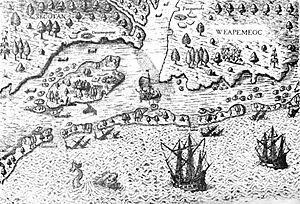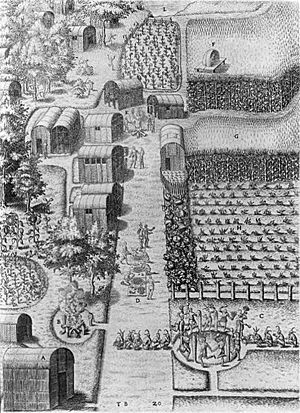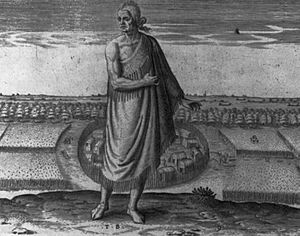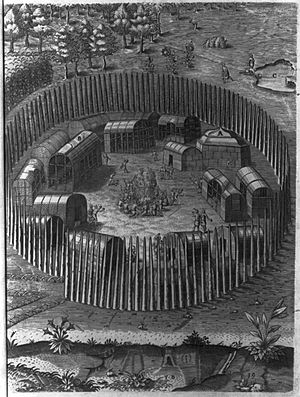Pamlico facts for kids
| Total population | |
|---|---|
| Extinct as a tribe | |
| Regions with significant populations | |
| North Carolina | |
| Languages | |
| Algonquian (historical) | |
| Religion | |
| Tribal religion (historical) | |
| Related ethnic groups | |
| Chowanoke, Machapunga |
The Pamlico people were a group of Native Americans who lived in North Carolina. They were also known by names like Pampticough or Pomeiok. The Pamlico spoke a language called Algonquian, specifically a type known as Pamlico or Carolina Algonquian.
Contents
Pamlico Homeland: Where They Lived
The Pamlico Indians made their homes along the Pamlico River in North Carolina. This river and the large body of water it flows into, Pamlico Sound, were named after them. Even Pamlico County carries their name.
The Pamlico were one of the southernmost Algonquian tribes living along the Atlantic coast. They are special because scholars were able to collect some words from their language.
Pamlico History: A Look Back
The first English colonists who arrived in the area in 1585-86 called the Pamlico people Pomoui.
Challenges in the 17th Century
In 1696, a terrible disease called smallpox spread through the Pamlico and nearby Algonquian communities. This sickness greatly reduced their numbers.
In 1701, an explorer named John Lawson wrote about their Algonquian language. By 1710, there were so few Pamlico people left that they lived in just one small village.
By 1709, the total Algonquian population in North Carolina had dropped to about 600 people. Before the English arrived, there had been several thousand. The Tuscarora War, which lasted from 1711 to 1713, caused even more deaths among the Algonquian tribes who were allies.
During the war, the Tuscarora people sometimes fought against their own allies. Some Pamlico people might have been taken as slaves by the Tuscarora. By the end of the 1700s, only a few Algonquian people remained.
As their numbers decreased, the tribes also lost their lands. For example, the Weapemeoc Indians sold their lands in 1660 and 1662. They then moved further inland. By 1697, they were complaining about white settlers moving onto their new lands.
The English set aside a special area for the Chawanokes (Chowan) before 1700. This area was called a reservation. Its size was reduced from 12 to 6 square miles (16 km2) by 1707. The Chowanoke sold off more land in 1713. After the Tuscarora War, the Machapunga tribe also received a reservation. Other groups living near the Pamlico Sound joined either the Machapunga or the Tuscarora.
As more white settlers came to eastern Carolina, new European goods became common. Guns replaced bows and arrows in the 1700s. Iron hatchets took the place of wooden clubs. English clothes were also widely worn by the Native Americans. The chief of the Roanoke tribe even had an English-style house built in 1654.
Some traditional practices continued for a long time. Women kept making baskets from rushes and silk grass. They decorated these baskets with designs inspired by nature.
Alliances and Changes in the 18th Century
In the 1600s, the Chawanoke often had conflicts with their Algonquian neighbors in Virginia. They also continued their old fights with the Iroquoian Tuscarora. During the Tuscarora War, the Chawanoke actively helped the English against the Tuscarora.
However, the Machapungas and other tribes near Pamlico Sound changed their alliances. Before 1700, they fought against the Tuscarora and Coree. But in 1711, they joined forces with them against the English colonists. The Hatteras, Weapemeoc (including the Paspatank, Pasquotank, Poteskeet, Perquimans, and Yeopim) tribes were more used to English ways by then. They stayed on the side of the English.
There was not much open fighting between the Algonquian people and English colonists, except for the Tuscarora War. The Native Americans suffered more from diseases brought by the Europeans. Because their numbers were so small, trade with the English was not very important.
Selling strong alcoholic drinks to Native Americans was a big problem around 1700. Alcohol was banned from Native towns in 1703, but this rule was not strictly followed. Not much was done to educate Native Americans, even though English started to replace their native languages in the 1700s.
A small number of Native Americans were baptized as Christians by Anglican ministers. This happened throughout the late 1600s and 1700s. Tribe members started using English names (sometimes as extra names) shortly after 1700. Native American medicine men earned money by helping white settlers as well as their own people. Some settlers in North Carolina bought Native Americans as slaves. Others sent them to markets in the north. We do not know exactly how many Native Americans were enslaved.
Pamlico Culture: Daily Life and Traditions
The Pamlico people were skilled at making special dugout canoes. They used these boats to travel far distances. Pamlico tools and items have been found in places as far away as the North Atlantic.
Their diet included corn, fish, and other vegetables and fruits they grew. Besides hunting and farming, the groups living near the coast relied a lot on fishing and gathering shellfish. They would dry these foods over a fire or in the sun to preserve them. The Pamlico did not eat sturgeon fish. Raising cattle was recorded for the Paspatanks around 1700.
The Tuscarora War made life difficult for many Algonquian groups. English colonists destroyed the fields of the Machapunga and their allies. The Hatteras were stopped from planting by their enemies. In 1714-1715, they needed supplies from the colonial government to survive.
Their political system, with hereditary chiefdoms, was still working around 1700. Chiefs were buried in temples, just as before. Regular people could pay money to be buried in the temple area too. Shell beads, called wampum, were used as money. For example, they were used to pay back people who were victims of crimes.
Special Ceremonies
Marriage rules made it hard to find partners within their shrinking communities. They were not allowed to marry their first cousins. Because of this, people often married into other tribes. This helped to make bonds stronger between different tribes.
The huskenaw rite was a special ceremony for both boys and girls. It was like an initiation into adulthood. This ceremony usually happened around Christmas and lasted for five or six weeks. During this time, the young people stayed in a special building outside the village.
See also
 In Spanish: Pamlico para niños
In Spanish: Pamlico para niños






